
Za Kotěrou do branické vodárny
V roce 2011 uplynulo 140 let od narození jednoho z nejvýznam- nějších českých architektů Jana Kotěry. V roce 2012 a 2013 budou kotěrovské oslavy pokračovat, neboť oslaví sto let od dokončení jeho nejvýznamnější stavba - budova muzea v Hradci Králové. U příležitosti těchto výročí bude v nedávno skvěle zrekonstruovaném objektu přečerpávací stanice v Bráníku od téhož architekta pronesena přednáška na téma Veřejné stavby Jana Kotěry.
Jan Kotěra (1871-1923) je právem považován za zakladatele české moderní architektury. Jeho schopnosti organizace uměleckého provozu, poskytování příležitostí svým kolegům i žákům, velkorysost a bezbřehá píle a především - důsledné nepolevování z nároků na kvalitu provedení a precizní dokonalosti a souhry všech složek architektury - z něj učinily jednu z nejzajímavějších postav české kultury 20. století. Nebývalý evropský rozhled, školení ve správný čas na správném místě (atelier Otty Wagnera na Vídeňské akademii v polovině 90. let 19. stol.), cit pro detail, materiál, účelnost a požadavky po moderním výrazu, to vše jsou charakteristiky tohoto jedinečného architekta. Hodnoty, které nám Kotěrova architektura dodnes předává, bychom měli zvláště v dnešní době nejistot a pochybných kvalit veřejné architektury nejen ctít, ale stále si připomínat.
Přednáška představí nejen jubilující budovu muzea ve východočeské metropoli (1909-1913), ale též samotný projekt vodárny na Zelené lišce v Michli a k ní náležející přečerpávací stanice v Bráníku (1904). Na tuto realizaci navázala stavba vodárenské věže v Třeboni (1909), která jako by té Michelské z oka vypadla. Kromě toho se představí rovněž Kotěrovy špičkové nakladatelské domy (Laichterův dům na Vinohradech /1908-9/ a Urbánkův dům, tzv. Mozarteum /1910-13/ v těsném sousedství Václavského náměstí). Kromě toho bude řeč též o monumentálních kubizujících stavbách jako je Všeobecný penzijní ústav (1912-14) nebo pozdější budova Vítkovického horního a hutního těžařstva (1921-24). Kotěru přežil dlouho se vlekoucí projekt Právnické a teologické fakulty, který trval neuvěřitelných patnáct let (první náčrtky jsou datovány rokem 1907, budova byla dokončena po Kotěrově smrti v roce 1923 jeho žákem Ladislavem Machoněm). Řeč se ale stočí i na jeden z prvních Kotěrových tzv. Gesamtkunstwerků, Okresní dům v Hradci Králové (1903-1904) nebo nalidovělý dodnes uchvacující Národní dům v Prostějově (1905-7). Chybět nebudou ani nejrůznější efemérní projekty, jako třeba Kotěrovy návrhy na scénu Rusalky (1901). Přednáška bude doplněna čtením nejzásadnějších momentů z textů, které měly na Kotěrovu tvorbu nejmarkantnější vliv, jako byla kniha B. Scotta Dům a zahrada, Wagnerův spisek O moderní architektuře, ale i úryvků z Kotěrových textů autorských (O novém umění ve Volných směrech).
Přednáška se koná 16. 2. 2012 od 18.00 v sále hlavní budovy areálu přečerpávací stanice Vršovické vodárny v Braníku.
Přednáší Ladislav Zikmund-Lender, autor monografického průvodce Trmalovou vilou v Praze, autor chystané monografie budovy muzea v Hradci Králové, přispěvatel do řady kolektivních monografií (Rodinné domy Jana Kotěry, Slavné vily Plzeňského kraje, O krajině a zahradě aj.) a časopisů (Architekt, Atelier, Art&Antiques).
Hostem pořadu bude scénárista a milovník architektury Pavel Cmíral.
Jan Kotěra (1871-1923) je právem považován za zakladatele české moderní architektury. Jeho schopnosti organizace uměleckého provozu, poskytování příležitostí svým kolegům i žákům, velkorysost a bezbřehá píle a především - důsledné nepolevování z nároků na kvalitu provedení a precizní dokonalosti a souhry všech složek architektury - z něj učinily jednu z nejzajímavějších postav české kultury 20. století. Nebývalý evropský rozhled, školení ve správný čas na správném místě (atelier Otty Wagnera na Vídeňské akademii v polovině 90. let 19. stol.), cit pro detail, materiál, účelnost a požadavky po moderním výrazu, to vše jsou charakteristiky tohoto jedinečného architekta. Hodnoty, které nám Kotěrova architektura dodnes předává, bychom měli zvláště v dnešní době nejistot a pochybných kvalit veřejné architektury nejen ctít, ale stále si připomínat.
Přednáška představí nejen jubilující budovu muzea ve východočeské metropoli (1909-1913), ale též samotný projekt vodárny na Zelené lišce v Michli a k ní náležející přečerpávací stanice v Bráníku (1904). Na tuto realizaci navázala stavba vodárenské věže v Třeboni (1909), která jako by té Michelské z oka vypadla. Kromě toho se představí rovněž Kotěrovy špičkové nakladatelské domy (Laichterův dům na Vinohradech /1908-9/ a Urbánkův dům, tzv. Mozarteum /1910-13/ v těsném sousedství Václavského náměstí). Kromě toho bude řeč též o monumentálních kubizujících stavbách jako je Všeobecný penzijní ústav (1912-14) nebo pozdější budova Vítkovického horního a hutního těžařstva (1921-24). Kotěru přežil dlouho se vlekoucí projekt Právnické a teologické fakulty, který trval neuvěřitelných patnáct let (první náčrtky jsou datovány rokem 1907, budova byla dokončena po Kotěrově smrti v roce 1923 jeho žákem Ladislavem Machoněm). Řeč se ale stočí i na jeden z prvních Kotěrových tzv. Gesamtkunstwerků, Okresní dům v Hradci Králové (1903-1904) nebo nalidovělý dodnes uchvacující Národní dům v Prostějově (1905-7). Chybět nebudou ani nejrůznější efemérní projekty, jako třeba Kotěrovy návrhy na scénu Rusalky (1901). Přednáška bude doplněna čtením nejzásadnějších momentů z textů, které měly na Kotěrovu tvorbu nejmarkantnější vliv, jako byla kniha B. Scotta Dům a zahrada, Wagnerův spisek O moderní architektuře, ale i úryvků z Kotěrových textů autorských (O novém umění ve Volných směrech).
Přednáška se koná 16. 2. 2012 od 18.00 v sále hlavní budovy areálu přečerpávací stanice Vršovické vodárny v Braníku.
Přednáší Ladislav Zikmund-Lender, autor monografického průvodce Trmalovou vilou v Praze, autor chystané monografie budovy muzea v Hradci Králové, přispěvatel do řady kolektivních monografií (Rodinné domy Jana Kotěry, Slavné vily Plzeňského kraje, O krajině a zahradě aj.) a časopisů (Architekt, Atelier, Art&Antiques).
Hostem pořadu bude scénárista a milovník architektury Pavel Cmíral.
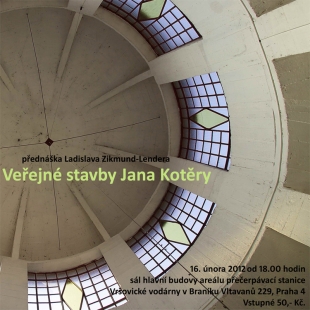
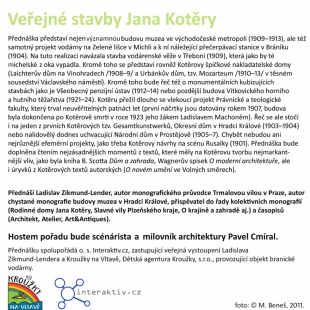
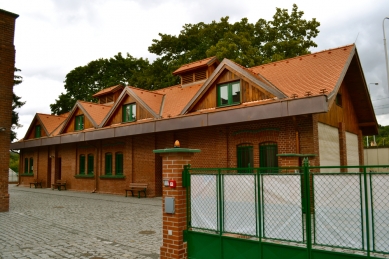
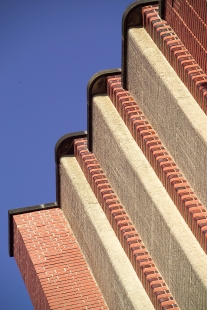
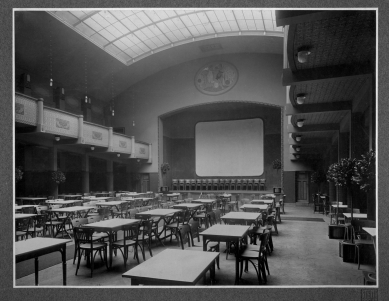
3 comments
add comment
Subject
Author
Date
Opakování???
germ
15.02.12 10:19
Bráník
germ
16.02.12 08:51
A bude se přednáška ještě někdy opakovat?
Dr.Lusciniol
17.02.12 11:02
show all comments









